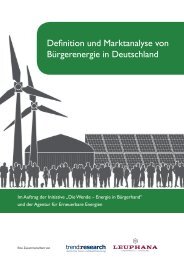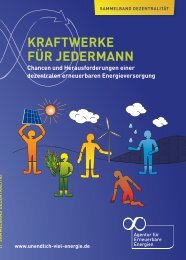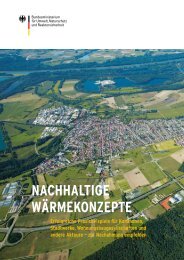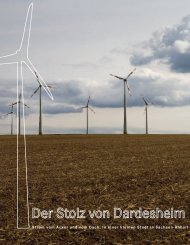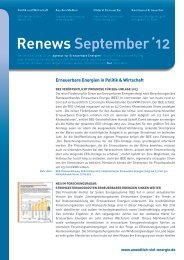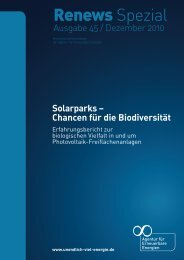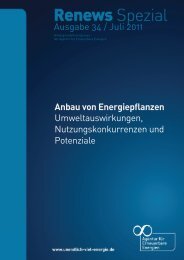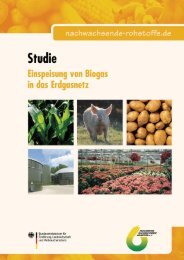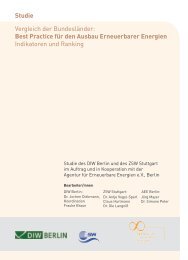Solar parks - Agentur für Erneuerbare Energien
Solar parks - Agentur für Erneuerbare Energien
Solar parks - Agentur für Erneuerbare Energien
Create successful ePaper yourself
Turn your PDF publications into a flip-book with our unique Google optimized e-Paper software.
Renews Special Best practice recommendations Issue 45 | p 28 p 29 | Issue 45 Renews Special <strong>Solar</strong> <strong>parks</strong> – Opportunities for Biodiversity<br />
Because of the size of the Lieberose solar park and to maintain a route historically used by red deer,<br />
the original development area was divided into two separate sections, creating a wildlife corridor. In<br />
addition, an appropriate 10 cm clearance under the fence allows smaller mammals and amphibians to<br />
pass through and avoids carving up their habitats.<br />
2.3. Measures during plant operation<br />
a. Knowledge gain through long-term monitoring<br />
Monitoring can improve nature conservation measures in solar <strong>parks</strong>. (Photo: First <strong>Solar</strong> GmbH)<br />
Scientific research should be conducted over several years to document the impacts of solar <strong>parks</strong> on<br />
the living environment and to demonstrate and monitor the effectiveness of compensatory measures.<br />
Monitoring is a necessary and efficient tool that can answer questions relating to nature conservation<br />
and make informed statements about the ecological impacts of solar <strong>parks</strong>. Monitoring is not a direct<br />
means of conserving biodiversity, but it makes it possible to check on the measures undertaken and<br />
can therefore provide information for developing new measures. Continuous, systematic monitoring<br />
over longer time periods makes it possible to draw reliable conclusions about the influence of certain<br />
environmental factors on animal and plant life.<br />
The solar plant on the roof of the underground drinking water cistern in Berlin-Tegel with its areas of protected fresh and dry sandy grassland is a unique biotope. (Photo:<br />
First <strong>Solar</strong> GmbH)<br />
One scientific study began in summer 2009 while the photovoltaic plant at the Tegel waterworks in<br />
Berlin was still under construction. The site contains some protected biotopes and it was suspected<br />
that there would be a change in the light and water conditions, especially in the immediate vicinity of<br />
the photovoltaic modules. As a result, a monitoring programme was created in 2009 for a period of 5<br />
years (2009-2013). The objective is to conduct a scientific investigation into the impacts of solar <strong>parks</strong> on<br />
legally protected grassland biotopes.<br />
The Lieberose solar park is located in a European Special Protection Area for birds. In order to observe the<br />
impacts of the construction and operation of the solar park and of the planned compensatory measures<br />
on the conservation aims and animal species, a monitoring programme was set up. It began by recording<br />
the bird population before the start of construction. The studies are being conducted regularly over a<br />
10-year period. If the monitoring results identify a need for action during this time, further measures<br />
are planned to protect the birds. The initial results show that the compensatory measures have been<br />
successful in compensating for the construction-related loss of nesting places for the tawny pipit, a<br />
species of bird that is highly endangered in Brandenburg (Red List category 2).<br />
The tawny pipit, which likes open spaces, is happy to take up residence in solar <strong>parks</strong>. (Photo: Steve Klasan)



